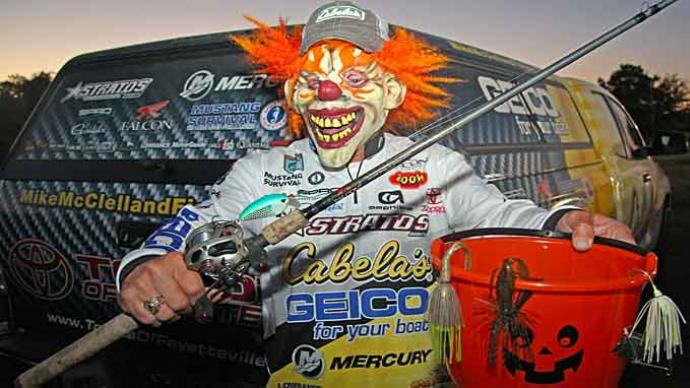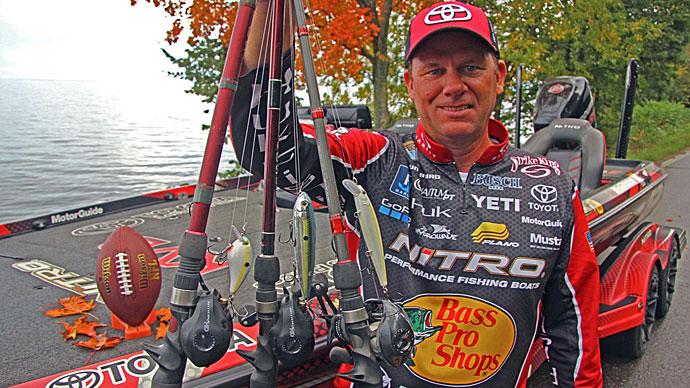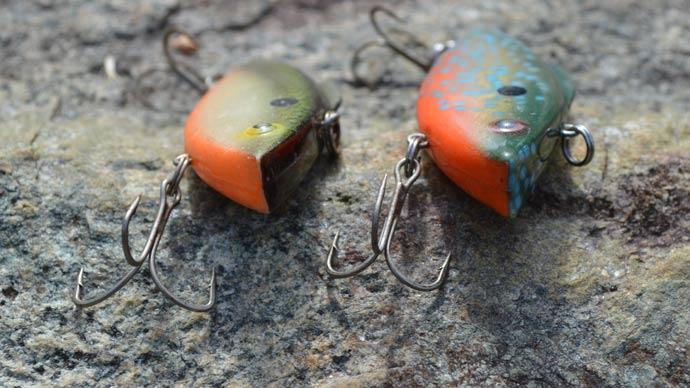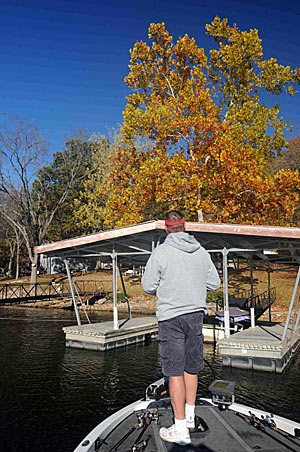
You can about throw anything in your tackle box to catch bass during their fall-feeding frenzy.
When weather conditions are right, and bass are chowing down on baitfish, you can trick them into biting any fast-moving lure that resembles their forage. However, fall weather can be fickle, and the bite can shut down after a cold front, so you will need some slow-moving baits, too, to coax lethargic bass into biting. You will also have to slow down your presentation during the fall turnover when bass are too moody to chase down bait.
Bass can be found throughout all levels of the water column as the water temperatures drop throughout the fall, so you can catch bass from the surface to the bottom during this season. Rigging your rods with lures that can be worked on the water column's top, middle, and bottom layers is a must during the fall because bass might use all of those zones throughout an autumn day, depending on the weather and light conditions.
Shad and bluegill are the primary bass forage in the fall on the Ozarks lakes close to my home, so I select lures that best imitate the bass’ favorite food. Here are my five favorite fall lures for catching bass from top to bottom.
Topwater Lures
Fall offers some of the best topwater action of the year, so I throw various surface lures to get in on the fun.
My topwater choices depend on the water conditions and the fish's aggressiveness. When bass are busting through shad pods on the surface in clear water, I prefer walking a Zara Spook through the surface activity. If there is a slight surface chop in stained water, I switch to the Berkley Choppo, which creates a plopping noise to trigger strikes from bass hovering under the baitfish. Murky water requires a noisy lure to draw bass to the top, so I opt for a buzzbait with a clacker head to trigger strikes.
Crankbaits
These lures allow me to fish either shallow or deep throughout the fall. My choice for cranking in the shallows is a square bill crankbait, which is excellent for banging into wood cover and rocks or running along the sides of docks. The lure’s square bill deflects the crankbait off of wood and rocks to trigger reaction strikes from bass hiding in the cover.
Some fall bass hang out in deeper brush piles throughout the fall, so if the shallow bass are inactive, I target the brush pile bass with a deep-diving crankbait. I select a deep diver that will run down and tick the top of the brush to tempt bass suspended above the cover.
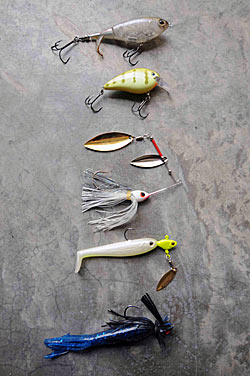
Bass feeding in the shallows start moving out to deeper water by late fall, so I switch to a medium-diving crankbait to catch these migrating fish. A chrome-and-black or chrome-and-blue Storm Lures Wiggle Wart is my pick for cranking along main and secondary points.
Spinnerbaits
From the middle to late fall, I will throw a tandem willowleaf spinnerbait whenever the wind blows. When the fish are gorging on shad in the shallows, I opt for a 3/8-ounce spinnerbait that I retrieve at a medium pace to keep the lure off the bottom. This shad-imitator is excellent for probing bass ambush points such as running through limbs of laydown logs, bumping into stumps, and winding along the floats of boat docks.
A blade bait is also an effective surface lure for me whenever bass ignore or short-strike a buzzbait. I switch to a 1/2-ounce spinnerbait with magnum-size willowleaf blades for waking the lure across the surface. I retrieve the lure at a fast speed to where the blades are bulging but not breaking the surface throughout my presentation.
Swimbaits
This lure is a finesse alternative to the spinnerbait I rely on when fishing clear water with a light chop on the surface. The swimbait allows me to fish in shallow water by rigging it on a 1/8- or 1/4-ounce swimbait jighead or deeper water by matching it with a 1/2-or 3/4-ounce jighead. Swimbaits come in various sizes and colors, so I can easily find a lure in the right size and color to match the baitfish bass are eating that day.
I also use swimbaits on Alabama rigs throughout the fall to imitate a school of baitfish. I attach 3-inch swimbaits on my Alabama rig in early fall when bass eat smaller shad and change to 5-inch swimbaits in late fall when larger gizzard shad are the primary forage for bass.
Jigs
The versatile jig will catch both aggressive and inactive bass throughout autumn. If bass ignore or short-strike my spinnerbait when I run it along the sides of docks, I change to a 1/4- or 3/8-ounce gray jig tipped with a blue plastic craw to get better hookups. I retrieve the jig at a steady pace and occasionally twitch my rod, so the lure stays just under the dock’s float where bass are hiding in the shade.
After a cold front hits or the turnover occurs and bass turn sluggish, I favor a finesse jig tipped with a flipping tube to create a slow-falling lure. I pitch the jig to any available cover and let it fall to the bottom. If an inactive bass ignores the jig on the initial fall, I let the lure sit on the bottom for a couple of seconds and then lift and drop the jig several times. I retrieve the lure quickly and pitch it to another target if the lift-and-drop presentation fails to trigger a bite.
BassResource may receive a portion of revenues if you make a purchase using a link above.


